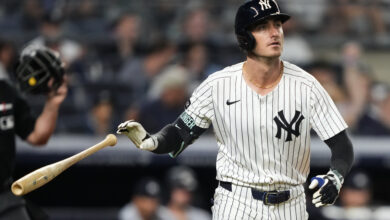
Justin Steele Put Health Concerns to Bed Quicker Than He Sat Down Padres
If anyone harbored concerns about Justin Steele‘s health after he was scratched from his first scheduled start due to arm fatigue, it was banished about 47 seconds into Friday’s game against the Padres. It took the lefty all of eight pitches to retire the side on three grounders in the bottom of the 1st inning, then he needed only 10 tosses to get three more outs in the next frame.
He worked so quickly that he had to go out to the bullpen to throw another 25 pitches just to continue stretching out. That kind of efficiency hasn’t been one of Steele’s calling cards in the past, as his career 10.1% walk rate is nearly two points higher than league average. If he’s able to eliminate some of those extra pitches and plate appearances, he’ll surely extend his average start beyond five innings.
As he explained to Pat Hughes and Rick Sutcliffe during Marquee’s broadcast, that was a big focus for him over the winter.
“I feel really good locating both the four-seam and the slider, have been for the past — I don’t know,” Steele said. “The whole entire offseason, that’s all I was working on, was working on commanding my pitches. And I was also working on developing that changeup, didn’t really have a chance to throw it tonight, they were putting the ball in play, but really happy with the results tonight. It’s everything I’ve been working on the offseason and commanding the pitches.”
The changeup is something I’ve been blathering about for years now and I am very excited to see what Steele can do if he’s truly able to bring it along as a viable third pitch. We should get a look at his offspeed in his next start, provided he doesn’t once again mow down opponents so quickly that he doesn’t need to throw anything other than fastball and slider.
While Steele’s performance was impressive in its own right, he also set the tone for the rest of the staff as the Cubs cruised through a combined no-hitter — their first ever in spring training — in just 2 hours and 14 minutes. Most of that time was tied up in the latter third of the game, as the 6th inning started right about an hour after first pitch. That was less about the pitch clock than it was having pitchers who naturally work fast and limited offense on both sides.
Since we’re already here, let’s talk about the pitch clock. I love it, though some folks have expressed disdain because they feel it makes games seem rushed. I’d argue that it only seems rushed now because people got used to batters taking their sweet-ass time getting out of the box and pitchers taking a walkabout after every throw, then there’s the matter of putting the clock in the score bug. Take out that countdown and I guarantee negative perceptions will soften immediately.
If you were watching a matchup between Greg Maddux and Mark Buehrle, you would marvel at how both pitchers worked quickly and efficiently. No one would complain that it felt rushed because that’s the natural flow of the game. Some see the clock as an infringement upon the game’s freedoms, an unnatural alteration to the sport’s purity, but it’s really just about getting things back to the way they were.
Listen, I love baseball as much as anyone and I’ve pretty much devoted my life to it as a player, fan, writer, and coach for the last 40 years, but I’ve also got more to do than watching Cubs games. So if there’s a way for me to get an extra 15-30 minutes back in 162 of my days, you can be damn sure I’m all for it. Thanks for indulging me in that tangent.
The real story here is Steele’s incredible effort and what it signals about the rest of his season, which could very well see him ascending to the top spot in the rotation. There’s a long way to go and he’s got to stay healthy, but I think we’re going to see something special from him.

